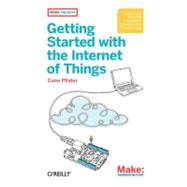
What is included with this book?
| Preface | p. v |
| Introduction | p. 1 |
| Hello World | p. 3 |
| Setting Up the Development Environment | p. 3 |
| Hello World | p. 4 |
| Building the Program in Visual Studio | p. 5 |
| Deploying to the Device | p. 6 |
| Writing to Actuators | p. 11 |
| Blinking Led | p. 11 |
| Reading from Sensors | p. 15 |
| Light Switch | p. 15 |
| Voltage Reader | p. 20 |
| Device as HTTP Client | p. 27 |
| The Internet of Things | p. 29 |
| HTTP | p. 30 |
| Push Versus Pull | p. 34 |
| Pachube | p. 37 |
| Hello Pachube | p. 43 |
| Setting Up the Network Configuration | p. 43 |
| Hello Pachube | p. 48 |
| What Netduino Said to Pachube | p. 55 |
| What Pachube Said to Netduino | p. 57 |
| Sending HTTP Requests-The Simple Way | p. 61 |
| Simple Put Request | p. 61 |
| Making Web Requests | p. 64 |
| Sending HTTP Requests-The Efficient Way | p. 71 |
| Efficient Put Request | p. 71 |
| Hello Pachube (Sockets Version) | p. 77 |
| Pachube Client | p. 77 |
| Device as HTTP Server | p. 83 |
| Hello Web | p. 85 |
| Relaying Messages to and from the Netduino | p. 85 |
| Hello Web | p. 87 |
| Request Handlers | p. 92 |
| Hello Web Html | p. 93 |
| What You Should Know About Ports | p. 94 |
| Handling Sensor Requests | p. 97 |
| From Sensor Readings to HTTP Resources | p. 98 |
| URIs of Measured Variables | p. 98 |
| Voltage Monitor | p. 99 |
| What You Should Know About HTTP GET | p. 103 |
| Handling Actuator Requests | p. 105 |
| From HTTP Resources to Controlling Things | p. 106 |
| URIs of Manipulated Variables | p. 106 |
| Led Controller | p. 107 |
| Test Client in C# | p. 111 |
| Embed a Java Script Test Client on the Netduino | p. 114 |
| What You Should Know About HTTP PUT | p. 118 |
| Going Parallel | p. 121 |
| Multithreading | p. 122 |
| Parallel Blinker | p. 132 |
| What You Should Know About Multithreading | p. 136 |
| Where Can I Go from Here? | p. 137 |
| Recipes for Modifying a Server | p. 137 |
| Server Versus Client? When to Push, When to Pull? | p. 143 |
| Taking a REST | p. 144 |
| Communities | p. 145 |
| Other Hardware | p. 145 |
| The Sky Is the Limit | p. 148 |
| Test Server | p. 149 |
| NET Classes Used in the Examples | p. 153 |
| Gsiot.Server Library | p. 155 |
| Index | p. 169 |
| Table of Contents provided by Ingram. All Rights Reserved. |
The New copy of this book will include any supplemental materials advertised. Please check the title of the book to determine if it should include any access cards, study guides, lab manuals, CDs, etc.
The Used, Rental and eBook copies of this book are not guaranteed to include any supplemental materials. Typically, only the book itself is included. This is true even if the title states it includes any access cards, study guides, lab manuals, CDs, etc.